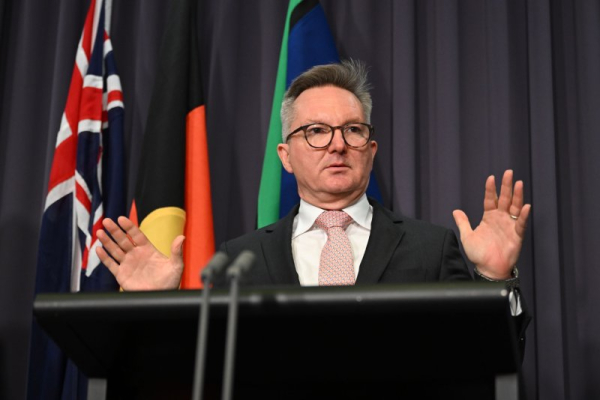

Australian Energy and Climate Change Minister Chris Bowen addresses the media at the release of the first major assessment of the risks climate change poses to the country. Photo by Lukas Coch/EPA
More than 1.5 million Australians will be at risk from sea level rise by 2050, amid an uncertain future in which climate change will make extreme weather events both more frequent and more severe, according to the country’s first national, comprehensive climate report.
The 72-page National Climate Risk Assessment published Monday found every part of society was already feeling the impact of climate change-fueled floods, cyclones, heatwaves, droughts and bushfires and that these hazards would spread, affecting people and places that hadn’t previously experienced them.
Warning that past weather was no longer on its own a reliable indicator of future risk, the report by the Australian Climate Service warned the country was currently experiencing “compounding and cascading hazards” that would increase going forward, posing risks to people, regions and Australia’s way of life.
Already disadvantaged individuals and households will likely be most affected, while Aboriginal and Torres Strait Islander people are singled out as facing singular risks to their efforts to achieve self-determination and prospects for social and physical health and well-being.
Coastal communities and cities will be impacted “significantly” by sea level rise and increased coastal hazards, with the report warning of an increase in such settlements in high and very high risk areas across Australia.
Even assuming no population rise overall, the number of people living in areas that will be affected by SLR and coastal flooding by 2030 was 597,000, rising to more than 1.5 million by 2050, the report found.
Working off escalating temperature rise scenarios, the report found 1.5 degrees Celsius rise would lift sea levels by 5.5 inches. However, a 3 degrees Celsius rise would produce almost quadruple sea rise of 21.3 inches.
Northern Australia faces a catalogue of across-the-board threats from extreme heat and heatwaves impacting health and mortality and affecting people’s ability to respond to disasters, increased risk from vector-borne diseases such as malaria and disruption to supply chains serving remote communities.
Future climate change will also reduce the capacity to support biodiversity of many of Northern Australia’s unique ecosystems, including Eucalypt woods, rainforest and coral reefs such as the Great Barrier Reef.
Risks to remote communities across the country, already vulnerable due to structural power, telecommunications and supply chain weaknesses, will only increase as disruption of critical infrastructure becomes more frequent.
People may also be forced to relocate from high-risk zones with knock-on economic, social and cultural impacts. Increasing risk in one system will spill over to affect multiple services and structures.
For example, property damage, higher insurance premiums, a cumulative $406 billion hit to the value of real estate, and even destruction of homes in areas with increased SLR and coastal erosion, will strain household finances and add to existing cost-of-living pressures.
Pursuits fundamental to the national lifestyle will be affected from sport to outdoor recreation, with floods and bush fires degrading the water quality Australians take forgranted and increasing pressure on limited sources of fresh water.
Alongside Monday’s report, the government launched a National Adaptation Plan outlining the extensive work it said it was already undertaking, including Australia’s first National Health and Climate Strategy, a National Disaster Risk Reduction Framework and hundreds of infrastructure, emergency management and disaster resilience projects paid for through its $666 million Disaster Ready Fund.
“Australians are already living with the consequences of climate change today, but it’s clear every degree of warming we prevent now will help future generations avoid the worst impacts in years to come,” Climate Change and Energy Minister Chris Bowen said in a news release.
“After a decade of denial and delay, we are acting on climate change — and it’s working. Emissions are coming down, there is record investment in clean energy and we’re working alongside communities to respond and adapt to the impacts,” said Bowen.
The release of the climate risk assessment came before the government was set to unveil, on Thursday or Friday, its emissions reduction targets for 2035 amid criticism of its ongoing high dependence on fossil fuels for energy.
Its current 2030 target is a cut of 43%.